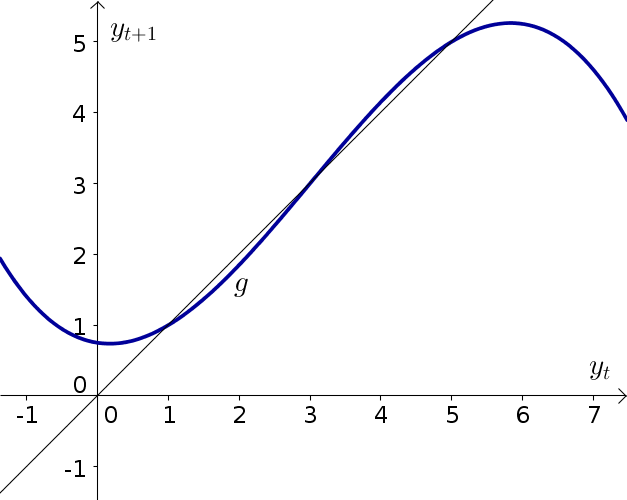Elementary discrete dynamical systems problems
Problem 1
Consider the dynamical system \begin{align*} x_{n+1} &= f(x_n) \quad \text{for $n=0,1,2,3, \ldots$ ,} \end{align*} where the function $f$ is graphed along with the diagonal $x_n = x_{n+1}$, below.

- Find the equilibria of the dynamical system. Indicate them on the graph along as well as list them with their approximate numerical values.
- Using cobwebbing, determine the stability of each equilibrium. Be sure to indicate the direction of your cobwebbing with arrows.
Problem 2
Consider the dynamical system \begin{align*} y_{t+1} &= g(y_t) \quad \text{for $t=0,1,2,3, \ldots$ ,} \end{align*} where the function $g$ is graphed along with the diagonal $y_t = y_{t+1}$, below.

- Find the equilibria of the dynamical system. Indicate them on the graph along as well as list them with their approximate numerical values.
- Using cobwebbing, determine the stability of each equilibrium. Be sure to indicate the direction of your cobwebbing with arrows.
Problem 3
Consider the dynamical system \begin{align*} q_{t+1} - q_t = \frac{a q_t +b}{c}, \quad \text{for $t=0,1,2,3, \ldots$} \end{align*} where $a$, $b$, and $c$ are parameters. Find all equilibria.
Problem 4
Consider the dynamical system \begin{align*} m_{n+1} - m_n = \frac{b m_n +c}{d}, \quad \text{for $n=0,1,2,3, \ldots$} \end{align*} where $b$, $c$, and $d$ are parameters. Find all equilibria.
Problem 5
Consider the dynamical system \begin{align*} r_{t+1} = \frac{a r_t +b}{c}, \quad \text{for $t=0,1,2,3, \ldots$ } \end{align*} where $a$, $b$, and $c$ are parameters. Find all equilibria.
Problem 6
Consider the dynamical system \begin{align*} c_{t+1}-c_{t} = \frac{(c_t -a)(c_t-b)}{d}, \quad \text{for $t=0,1,2,3, \ldots$ } \end{align*} where $a$, $b$, and $d$ are parameters. Find all equilibria.
Problem 7
Consider the dynamical system \begin{align*} b_{n+1}-b_{n} = \frac{(b_n -\alpha)(b_n-\beta)(b_n-\gamma)}{\delta}, \quad \text{for $n=0,1,2,3, \ldots$ } \end{align*} where $\alpha$, $\beta$,$\gamma$, and $\delta$ are parameters. Find all equilibria.
Problem 8
Consider the dynamical system \begin{align*} m_{t+1} - m_t = -\frac{a}{b} m_t + \frac{a}{b}c, \quad \text{for $t=0,1,2,3, \ldots$ } \end{align*} where $a$, $b$, and $c$ are parameters.
- If one doubles the parameter $a$ and doubles the parameter $b$, how does the dynamical system change?
- If you know that value of $\lambda = \frac{a}{b}$, do you need to know the values of $a$ and $b$ individually to determine the evolution of the dynamical system? Why or why not?
- Rewrite the dynamical system in terms of $\lambda$ and $c$ (with no dependence on $a$ or $b$ individually).
Problem 9
Consider the dynamical system \begin{align*} l_{n+1} = \frac{ab}{c} l_n e^{-l_n a b /c}, \quad \text{for $n=0,1,2,3, \ldots$ } \end{align*} where $a$, $b$, and $c$ are parameters.
- If one doubles the parameter $a$ and doubles the parameter $c$, how does the dynamical system change?
- If one doubles the parameter $b$ and doubles the parameter $c$, how does the dynamical system change?
- If one doubles the parameter $a$ and halves the parameter $b$, how does the dynamical system change?
- If you know that value of $\gamma = \frac{ab}{c}$, do you need to know the values of $a$, $b$, and $c$ individually to determine the evolution of the dynamical system? Why or why not?
- Rewrite the dynamical system in terms of $\gamma$ (with no dependence on $a$, $b$, or $c$ individually).
Problem 10
What is an equilibrium of a dynamical system? What does it mean for an equilibrium to be stable? To be unstable?
Problem 11
Consider the dynamical system \begin{align*} h_{t+1} -h_t &= \frac{h_t(h_t -1)}{2} \quad \text{for $t=0,1,2,3, \ldots$ .} \end{align*}
- Find the equilibria.
- If $h_0 = -0.1$, calculate $h_1$, $h_2$, $h_3$, and $h_4$.
- If $h_0= 0.1$, calculate $h_1$, $h_2$, $h_3$, and $h_4$.
- Based on the above calculations, what can you infer about the stability of one of the equilibria?
- If $h_0 = 0.99$, calculate $h_1$, $h_2$, $h_3$, and $h_4$.
- If $h_0= 1.01$, calculate $h_1$, $h_2$, $h_3$, and $h_4$.
- Based on the above calculations, what can you infer about the stability of one of the equilibria?
Problem 12
Consider the dynamical system \begin{align*} S_{t+1} -S_t &= \frac{S_t(1-S_t)}{2} \quad \text{for $t=0,1,2,3, \ldots$ .} \end{align*}
- Find the equilibria.
- If $S_0 = -0.01$, calculate $S_1$, $S_2$, $S_3$, and $S_4$.
- If $S_0= 0.01$, calculate $S_1$, $S_2$, $S_3$, and $S_4$.
- Based on the above calculations, what can you infer about the stability of one of the equilibria?
- If $S_0 = 0.9$, calculate $S_1$, $S_2$, $S_3$, and $S_4$.
- If $S_0= 1.1$, calculate $S_1$, $S_2$, $S_3$, and $S_4$.
- Based on the above calculations, what can you infer about the stability of one of the equilibria?
Problem 13
Consider the dynamical system \begin{align*} q_{n+1} -q_n &= a q_n \quad \text{for $n=0,1,2,3, \ldots$ } \end{align*}
where $a$ is a parameter.- Solve the dynamical system to give a formula for $q_n$ in terms of the initial condition $q_0$, the parameter $a$, and the number $n$.
- Find the equilibria.
- For each equilibrium, determine for which values of $a$ the equilibrium is stable.
Problem 14
Consider the dynamical system \begin{align*} p_{n+1} &= b p_n \quad \text{for $n=0,1,2,3, \ldots$ } \end{align*}
where $b$ is a parameter.- Solve the dynamical system to give a formula for $p_n$ in terms of the initial condition $p_0$, the parameter $b$, and the number $n$.
- Find the equilibria.
- For each equilibrium, determine for which values of $b$ the equilibrium is stable.
One you have worked on a few problems, you can compare your solutions to the ones we came up with.
Thread navigation
Elementary dynamical systems
Similar pages
- The idea of a dynamical system
- An introduction to discrete dynamical systems
- Developing an initial model to describe bacteria growth
- Bacteria growth model exercises
- Bacteria growth model exercise answers
- Exponential growth and decay modeled by discrete dynamical systems
- Discrete exponential growth and decay exercises
- Discrete exponential growth and decay exercise answers
- Doubling time and half-life of exponential growth and decay
- Constructing a mathematical model for penicillin clearance
- More similar pages